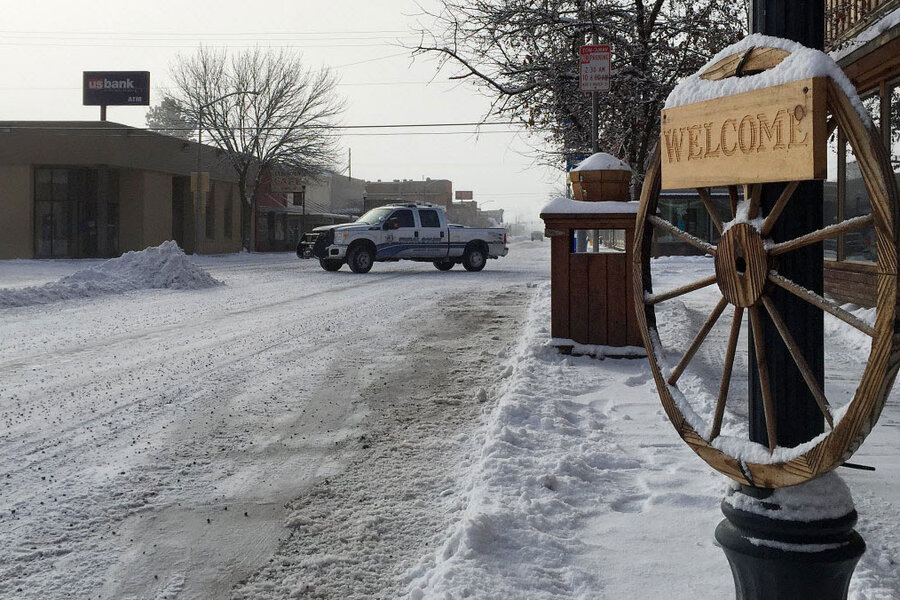Oregon standoff hits two-week mark: What do Burns, Ore. residents say?
Loading...
Over the past two weeks, locals in Burns, Ore., have seen their town transform into a war zone. Police from around the state have set up a command center in the town’s courthouse. Streets are blocked off.
On January 2nd, a group of armed men named the Citizens for Constitutional Freedom took over the Malheur National Wildlife Refuge, and refused to leave. The occupation began in response to the reimprisonment of cattle ranchers Dwight and Steven Hammond, who were initially arrested for lighting brush fires that spread to federal land.
Burns is about thirty minutes away from the wildlife refuge, a tiny community with fewer than three thousand residents.
Many of those residents just want things to end peacefully. One local, Brenda Pointere, told the Associated Press that the most important thing was to remain calm. She said, "It started out calm, but the longer it goes on – you start to hear rumors."
As the standoff wears on, locals are growing increasingly weary of the tension. The presence of armed men, not far away, has led to a local school district shut down, as officials became uncertain they could guarantee the safety of children on their way to school.
Locals have sought conversations with militia leaders. On the first day of the standoff, Burns resident Brandy Mosher arranged a meeting attended by about sixty people. She hoped to facilitate dialogue between locals and militiamen.
At Ms. Mosher’s meeting, residents expressed fears that they would be left to clean up after the eventual end of the standoff. Local Shonna McKay told occupiers, “I am scared to death. Everyone here should know what your agenda is."
Idaho militiaman Brandon Curtiss responded, "We are not coming into your town to shoot it up. We won't fire anything unless we're fired upon."
Despite reassurances, some residents have reported harrassment. One local pastor, reported being followed and yelled at by unknown men in a truck with out of state plates, weeks before the occupation. Others have had unfamiliar cars park in their driveway. One police officer’s wife said fearfully, “Every gun in the house is loaded.”
Yet not all residents are fearful. Some support the protesters. One local mother, Talia Ward, said that she was frightened by the news at first, but has since begun to understand what the militiamen stand for. Now, she says, “I support them with all my heart. And I want something done.” Ms. Ward may not think the occupation is right, but she supports what the protesters stand for.
Ward is one of many locals, like Ben McCanna, who agree with the protesters in thought, but not in deed. Although he thinks what happened to the Hammonds was wrong, Mr. McCanna said, “I don't agree with anything they're doing right now.”
For many Burns residents, however, the demands of the protesters do not mesh with local wishes.
Early in January, NPR asked local Debbie Pfeiffer what she thought of the occupation.
"I don't like what's going on at the refuge," Ms. Pfeiffer said. "It's a little unsettling to have these outsiders come in and co-opt the community and, you know, tell us what we should think."
Bartender Patty Hodge concurred, saying “They’re here for their own agenda, not for the people of Harney County at all.”
Ryan Bundy disagreed with people like Ms. Pfeiffer, saying "I think the mass of the community, especially the rural community, are 100 percent in favor of what we're trying to accomplish here.”
Meanwhile, the whole incident has struck a strange chord with one local group. Burns Paiute Tribe members can relate to the protesters demands that the land be returned to the people, but have their own ideas about who the rightful owners of the land are. The Paiute Tribe does not like the presence of guns, but is also interested in the land.
“This land is disputed land and it’s Paiute land and native people should be at the table in this conversation,” said Beth Piatote, associate professor of Native American studies at University of California, Berkeley.
Despite the presence of some local support, and protesters’ claims that they speak for the community, residents gathered at a local forum this week to air their grievances with the militiamen in their midst. Judge Steven Grasty, one of the meeting’s coordinators said to outsiders, “Please go home. And now.”
This report contains material from the Associated Press.





